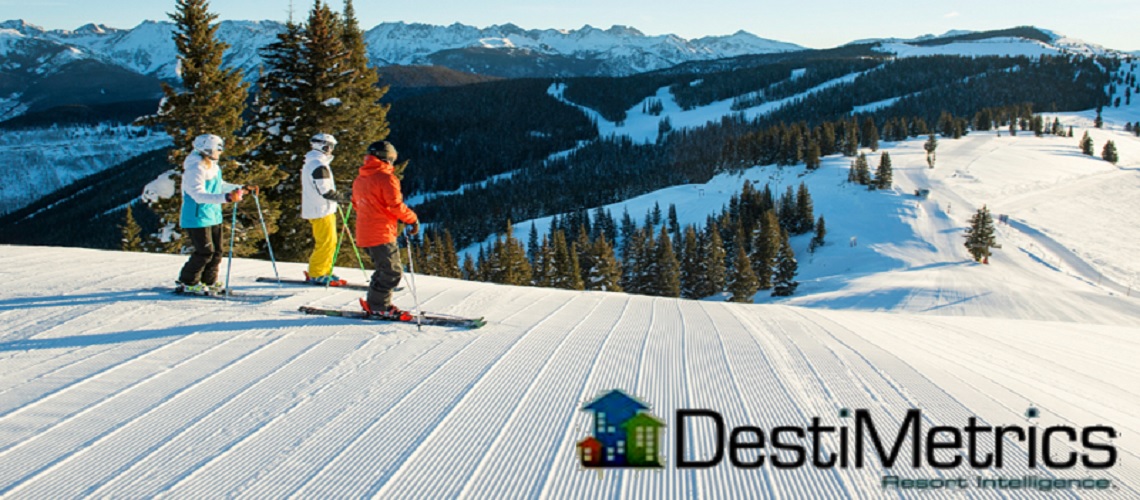Destimetrics: Revenue & Occupancy edging To Possible Winter Record Levels

A winter season that began on a downward trend in the wake of last year’s disappointing snow conditions, is now moving towards new records for occupancy and revenue, thanks to a strong economy and generous snowfall across most of North America. Inntopia released their monthly DestiMetrics* Market Briefing for the West yesterday and as of Feb. 28, actual occupancy for the month of February was up 5.7 percent compared to the previous February in a year-over-year (YOY) comparison. The Average Daily Rate (ADR) also edged up 2.3 percent during the month and the boost in both figures led to an aggregated 8.1 percent increase in revenue compared to February 2018.
For the full winter season that includes the months of November through April, aggregated occupancy is up 5.5 percent compared to last winter at this same time with increases in every month except for April. ADR has eked out an 0.7 percent gain for the season but is contributing to a healthy 6.3 percent increase in revenue for the season when coupled with consistently solid occupancy figures. Data for the winter season includes actual occupancy and revenue that is already “in the bank,” as well as on-the-books data for the remaining two months of the winter season.
“Skiers and riders have been spoiled for choice this season and are more likely to spend vacation dollars this year in response to the excellent slope conditions in virtually every region,” confirmed Tom Foley, senior vice president of Business Operations and Analytics for Inntopia. “Even some pretty erratic market fluctuations midwinter didn’t discourage destination visitors, and that demand has helped to support rates in recent weeks. However, we are still seeing some long-term softening in rate that has been a gradual and emerging trend for nearly a year,” he added.
Bookings made in February for arrivals in February were down 7.4 percent compared to last year at this time, but February 2018 was when the first significant amount of mid-season snowfall arrived, causing a surge of bookings in response to improved conditions. The optimism regarding another possible record season though is being driven by bookings made in February for arrivals in March which edged up 0.7 percent, and April showing some muscle with a robust 15.7 percent increase in bookings compared to the same time last year.
Economic indicators for February were mostly supportive of the continued strength of the season. The Dow Jones Industrial Average (DJIA) rose a sharp 4.1 percent from January and continued the recovery that started at the end of the partial government shutdown on Jan. 25. The DJIA is 3.8 percent higher than it was in February 2018. Consumers continued to exhibit confidence in present market conditions as the Consumer Confidence Index (CCI) bounced up eight percent to finish above 130 points for the sixth time in the past 12 months. The national Unemployment Rate dropped from four percent in January to 3.8 percent in February as fewer people were job hunting once the government shutdown ended. However, employers added only 20,000 new jobs in February--well below the 190,000 jobs expected. Wages once again increased during the month to help bolster consumer confidence.
“Although several economic indicators pointed to both a stable economy and investors’ faith in the current and immediate future, most analysts expect economic expansion to moderate in the coming months in direct contrast to consumer expectations,” cautioned Foley.
An early view of the summer booking pattern suggests that summer lodging in mountain destinations is currently on a positive track as of Feb. 28. In a year-over-year comparison to the same dates last year, bookings made in February for arrivals in May are up 22.3 percent and June is up 13.1 percent. In contrast, July bookings made in February were down 8.4 percent.
“It is no surprise that when reviewing 15 years of data, good snow conditions can offset even the most difficult economic situation,” Foley confirmed. “However, we are closely watching room rates which have been the driving force behind revenue gains for nearly a decade. Even in this high-demand year for mountain lodging, we are seeing continued signs of consumers pulling back and resisting additional rate increases,” concluded Foley.














